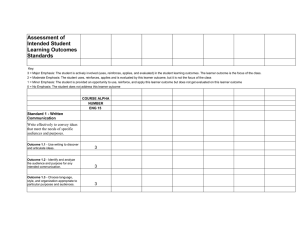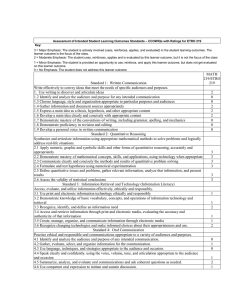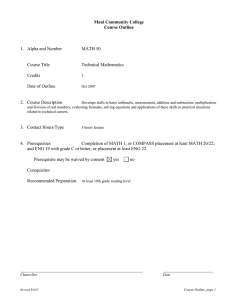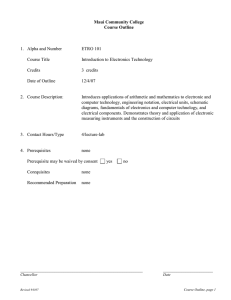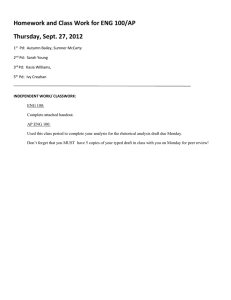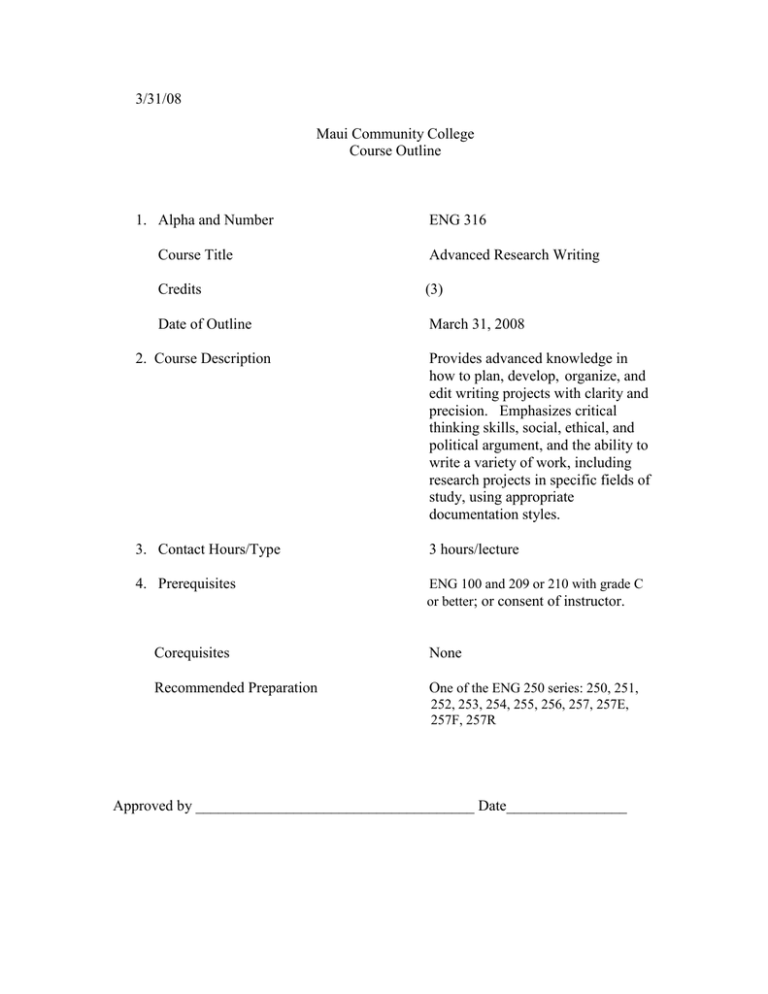
3/31/08
Maui Community College
Course Outline
1. Alpha and Number
ENG 316
Course Title
Advanced Research Writing
Credits
(3)
Date of Outline
March 31, 2008
2. Course Description
Provides advanced knowledge in
how to plan, develop, organize, and
edit writing projects with clarity and
precision. Emphasizes critical
thinking skills, social, ethical, and
political argument, and the ability to
write a variety of work, including
research projects in specific fields of
study, using appropriate
documentation styles.
3. Contact Hours/Type
3 hours/lecture
4. Prerequisites
ENG 100 and 209 or 210 with grade C
or better; or consent of instructor.
Corequisites
None
Recommended Preparation
One of the ENG 250 series: 250, 251,
252, 253, 254, 255, 256, 257, 257E,
257F, 257R
Approved by _____________________________________ Date________________
2
5. General Course Objectives
English 316 allows students to expand and demonstrate their critical thinking,
reading, and writing skills. The course presents a variety of strategies for writing
and research, including creating, drafting, evaluating, and presenting information.
Students will create sustained persuasive and analytical writing projects using
library and Internet research.
For detailed information on how ENG 316 focuses on the Maui Community
College general education standards, see the attached curricular grid.
ENG 316 satisfies 3 of the 12 credits of upper-division general education
requirements for the Applied Business and Information (ABIT) BAS degree.
6. Student Learning Outcomes
For assessment purposes, these are linked to #7. Recommended Course Content.
Upon completion of this course, a student will be able to:
a. Adopt a clear voice and stance;
b. Analyze, synthesize, and support complex ideas in clear, coherent writing;
c. Use form, content, language, and style appropriate to audience, purpose, and
subject;
d. Use argument persuasively and ethically to support an analysis or position.
e. Analyze readings for accuracy and content;
f. Demonstrate knowledge of appropriate documentation styles;
g. Use current available technology to maximize the effectiveness of written and
verbal communication;
h. Interpret, evaluate, and use information discerningly from various primary and
secondary sources, including appropriate data bases;
i. Write research papers;
j. Apply clear logic to readings and writing;
k. Demonstrate technological competency and information literacy;
l. Display critical analysis and reasoning
m. Use multiple modes of inquiry; and
n. Recognize diverse perspectives.
7. Recommended Course Content and Approximate Time Spent on Each Topic
Linked to #6. Student Learning Outcomes.
1-16 weeks
Read and evaluate various essays/articles (a, b, c, d, e, f, g, h, i, j,
k, l, m, n)
1-16 weeks
Write responses to various essays/articles (a, b, c, d, e, f, g, h, i, j,
k, l, m, n)
1-16 weeks
Write several sustained argumentative essays (a, b, c, d, e, f, g, h, i,
j, k, l, m, n)
3
1-16 weeks
Learn and apply appropriate documentation styles (a, b, c, d, e, f,
g, h, i, j, k, l, m, n)
8. Text and Materials, Reference Materials, Auxiliary Materials, and Content
An appropriate text(s) and material(s) will be chosen at the time the course is to
be offered from those currently available in the field. Examples include, but are
not limited to:
Faigley, Lester. The Brief Penguin Handbook. 2nd ed. N.Y: Pearson/Longman,
2006.
Hubbuch, Susan. Writing Research Papers Across the Curriculum. 5th ed.
Boston: Thomson Wadsworth, 2005.
Palmquist, Mike. The Bedford Researcher. 2nd ed. Boston: Bedford/St. Martin,
2006.
9. Recommended Course Requirements and Evaluation
Specific course requirements are at the discretion of the instructor at the time the
course is being offered. Requirements might include, but are not limited to:
5-15% Presentations
5-15% Participation
10-20% MidtermExamination
10-25% Final Examination
30-80% Research Projects
20-30% Short written responses to assigned readings
10. Methods of Instruction
Instructional methods may vary considerably with instructors. Specific methods
will be used at the discretion of the instructor teaching the course and might
include, but are not limited to:
a. lectures and class discussions
b. group activities
c. audio visual and internet exercises and research
d. group and/or individual presentations
e. journal writing
f. peer review
g. field research
h. guest speakers
3/31/08
4
Assessment of Intended Student Learning Outcomes Standards
Key:
3 = Major Emphasis: The student is actively involved (uses, reinforces, applies, and evaluated) in the student learning outcomes. The
learner outcome is the focus of the class.
2 = Moderate Emphasis: The student uses, reinforces, applies and is evaluated by this learner outcome, but it is not the focus of the class
1 = Minor Emphasis: The student is provided an opportunity to use, reinforce, and apply this learner outcome but does not get evaluated on
this learner outcome
0 = No Emphasis: The student does not address this learner outcome
COURSE
ALPHA
NUMBER
Standard 1 - Written Communication
Write effectively to convey ideas that meet the needs of specific audiences and purposes.
Outcome 1.1 - Use writing to discover and articulate ideas.
Outcome 1.2 - Identify and analyze the audience and purpose for any intended communication.
Outcome 1.3 - Choose language, style, and organization appropriate to particular purposes and audiences.
Outcome 1.4 - Gather information and document sources appropriately.
Outcome 1.5 - Express a main idea as a thesis, hypothesis, or other appropriate statement.
Outcome 1.6 - Develop a main idea clearly and concisely with appropriate content.
Outcome 1.7 - Demonstrate a mastery of the conventions of writing, including grammar, spelling, and mechanics.
Outcome 1.8 - Demonstrate proficiency in revision and editing.
Outcome 1.9 - Develop a personal voice in written communication.
ENG 316
3
3
3
3
3
3
3
3
3
Standard 2 - Quantitative Reasoning
Synthesize and articulate information using appropriate mathematical methods to solve problems of quantitative
reasoning accurately and appropriately.
Outcome 2.1 - Apply numeric, graphic, and symbolic skills and other forms of quantitative reasoning accurately and
appropriately.
Outcome 2.2 - Demonstrate mastery of mathematical concepts, skills, and applications, using technology when appropriate.
Outcome 2.3 - Communicate clearly and concisely the methods and results of quantitative problem solving.
Outcome 2.4 - Formulate and test hypotheses using numerical experimentation.
Outcome 2.5 - Define quantitative issues and problems, gather relevant information, analyze that information, and present
results.
Outcome 2.6 - Assess the validity of statistical conclusions.
1
1
1
1
1
1
Standard 3 - Information Retrieval and Technology
Access, evaluate, and utilize information effectively, ethically, and responsibly.
Outcome 3.1 - Use print and electronic information technology ethically and responsibly.
3
Outcome 3.2 - Demonstrate knowledge of basic vocabulary, concepts, and operations of information retrieval and technology.
3
3
Outcome 3.3 - Recognize, identify, and define an information need.
Outcome 3.4 - Access and retrieve information through print and electronic media, evaluating the accuracy and authenticity of
that information.
Outcome 3.5 - Create, manage, organize, and communicate information through electronic media.
Outcome 3.6 - Recognize changing technologies and make informed choices about their appropriateness and use.
Standard 4 - Oral Communication
Practice ethical and responsible oral communications appropriately to a variety of audiences and purposes.
3
2
3
5
Outcome 4.1 - Identify and analyze the audience and purpose of any intended communication.
Outcome 4.2 - Gather, evaluate, select, and organize information for the communication.
Outcome 4.3 - Use language, techniques, and strategies appropriate to the audience and occasion.
Outcome 4.4 - Speak clearly and confidently, using the voice, volume, tone, and articulation appropriate to the audience and
occasion.
Outcome 4.5 - Summarize, analyze, and evaluate oral communications and ask coherent questions as needed.
Outcome 4.6 - Use competent oral expression to initiate and sustain discussions.
Standard 5 - Critical Thinking
Apply critical thinking skills to effectively address the challenges and solve problems.
3
2
3
2
2
2
Outcome 5.3 - Formulate research questions that require descriptive and explanatory analyses.
3
3
3
3
Outcome 5.4 - Recognize and understand multiple modes of inquiry, including investigative methods based on observation and
analysis.
3
Outcome 5.1 - Identify and state problems, issues, arguments, and questions contained in a body of information.
Outcome 5.2 - Identify and analyze assumptions and underlying points of view relating to an issue or problem.
Outcome 5.5 - Evaluate a problem, distinguishing between relevant and irrelevant facts, opinions, assumptions, issues, values,
and biases through the use of appropriate evidence.
Outcome 5.6 - Apply problem-solving techniques and skills, including the rules of logic and logical sequence.
3
3
Outcome 5.7 - Synthesize information from various sources, drawing appropriate conclusions.
Outcome 5.8 - Communicate clearly and concisely the methods and results of logical reasoning.
3
Outcome 5.9 - Reflect upon and evaluate their thought processes, value system, and world views in comparison to those of
others.
3

